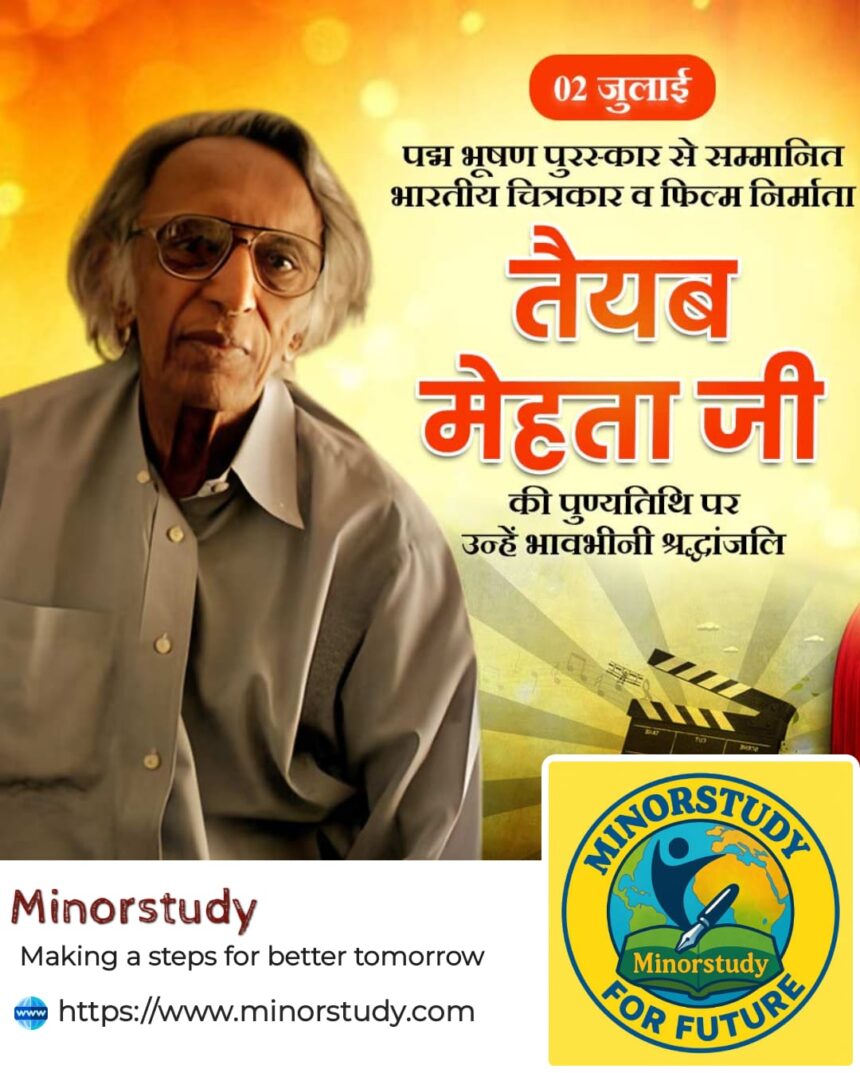7 Shocking Facts About Tyeb Mehta That Changed Indian Art Forever
A Journey Through History, Legacy, and the Everyday Impact of India’s Modern Art Revolutionary
- Introduction: Who Was Tyeb Mehta?
- Brief History of Tyeb Mehta
- 7 Shocking and Powerful Facts About Tyeb Mehta
- 1. A Witness to Partition That Haunted His Canvas
- 2. Introduced Indian Art to the Million-Dollar Club
- 3. Minimal Color, Maximum Emotion
- 4. A Reclusive Genius With Global Impact
- 5. Reimagined Hindu Mythology Through Modern Lenses
- 6. Mentored by and Influenced India’s Greatest Artists
- 7. From Film Editor to World-Class Painter
- Significance of Tyeb Mehta’s Work
- Timeline of Tyeb Mehta’s Artistic Journey
- FAQs About Tyeb Mehta
- Q1: What is Tyeb Mehta best known for?
- Q2: Why was his art so expensive?
- Q3: How did Partition affect him?
- Q4: What role did he play in Indian art history?
- Q5: Can I see his works in museums?
- Wishing & Remembering Tyeb Mehta
- Why Tyeb Mehta Matters in Our Life Today
- Conclusion: The Daily Life Impact of Tyeb Mehta’s Legacy
- ✅ Important Points Summary
Introduction: Who Was Tyeb Mehta?
Tyeb Mehta was not just a painter—he was a revolution in himself. Born on July 26, 1925, in Kapadvanj, Gujarat, and raised in the vibrant city of Mumbai, Tyeb Mehta emerged as one of India’s most iconic modern artists, whose bold, minimalist strokes captured the emotional turmoil and existential pain of post-independence India. A key member of the Bombay Progressive Artists’ Group, his art not only redefined Indian aesthetics but also fetched record-breaking prices globally.
Behind his fame lies a deeply human story of struggle, migration, trauma, and artistic transformation. Let’s dive deep into his history, legacy, shocking facts, FAQs, significance, and why Tyeb Mehta still matters in our daily life and society.
Brief History of Tyeb Mehta
1925: Born in a Dawoodi Bohra family in Gujarat, India.
1947: Witnessed the trauma of India’s Partition—an event that would later dominate the themes of violence and suffering in his works.
1952: Graduated from Sir J.J. School of Art, Mumbai.
1950s–60s: Traveled to London and Paris, influenced by European modernism and artists like Francis Bacon.
1970s–80s: Developed his signature “diagonal series,” an abstract yet deeply psychological style.
2002: Set a record at Christie’s by selling Celebration for ₹15 million, the highest for any Indian painting at the time.
2009: Passed away in Mumbai, leaving behind a powerful legacy of modernist masterpieces.
7 Shocking and Powerful Facts About Tyeb Mehta
1. A Witness to Partition That Haunted His Canvas
Tyeb Mehta witnessed a man being lynched during the Partition riots of 1947 in Mumbai. This single horrifying moment shaped the tragic, raw, and sometimes violent emotional tones of his work. His painting “Falling Figure” was a direct visual response to this trauma.
💬 “That image stayed with me forever.” – Tyeb Mehta
2. Introduced Indian Art to the Million-Dollar Club
His painting “Celebration” was auctioned for ₹15 million (USD 317,500) in 2002, marking India’s entry into the global fine art market. It was the first Indian painting to cross the ₹1 crore mark.
3. Minimal Color, Maximum Emotion
Mehta’s use of flat planes of color and sharp diagonals might look simple, but they were deeply symbolic. The diagonal line became his most recognizable motif—suggesting conflict, division, and human fragility.
4. A Reclusive Genius With Global Impact
Unlike many artists, Mehta was deeply introverted, avoiding public appearances and media. Yet his works traveled across London, Paris, New York, and Berlin, showcasing Indian modernism to the world.
5. Reimagined Hindu Mythology Through Modern Lenses
Paintings like “Kali”, “Durga Mahisasura Mardini”, and “Mahishasura” reinterpreted mythology with a dark, contemporary twist. These works expressed inner conflict, power struggles, and the duality of good vs evil.
6. Mentored by and Influenced India’s Greatest Artists
He was closely associated with M.F. Husain, S.H. Raza, F.N. Souza, and other members of the Progressive Artists’ Group, which revolutionized Indian art in post-colonial times.
7. From Film Editor to World-Class Painter
Before becoming a full-time painter, Mehta worked as a film editor at Famous Studios in Mumbai. This cinematic influence reflected in the movement and framing of his compositions.
Significance of Tyeb Mehta’s Work
Tyeb Mehta’s contribution is not just artistic—it’s emotional, philosophical, and sociopolitical. His works speak of violence, migration, mythology, suffering, and ultimately, human resilience. His style helped break away from colonial academic realism, introducing a uniquely Indian modernism.
Timeline of Tyeb Mehta’s Artistic Journey
| Year | Event |
|---|---|
| 1925 | Born in Kapadvanj, Gujarat |
| 1947 | Witnessed Partition riots in Mumbai |
| 1952 | Graduated from Sir J.J. School of Art |
| 1959 | Moved to London |
| 1964 | Returned to India |
| 1970s | Developed “diagonal” series |
| 1990s | Created mythological series like Kali and Mahishasura |
| 2002 | Celebration sold for ₹1.5 crore |
| 2009 | Passed away in Mumbai |
FAQs About Tyeb Mehta
Q1: What is Tyeb Mehta best known for?
He’s best known for his diagonal series and powerful reinterpretations of mythological figures like Kali and Mahishasura.
Q2: Why was his art so expensive?
Because of his rare works, emotionally deep themes, global appeal, and the minimal yet intense style—art collectors saw his pieces as invaluable.
Q3: How did Partition affect him?
The traumatic visuals of the Partition riots became a lifelong emotional motif in his artworks—especially Falling Figure and Trussed Bull.
Q4: What role did he play in Indian art history?
He helped globalize Indian modern art and gave it a contemporary visual language distinct from Western influences.
Q5: Can I see his works in museums?
Yes. His works are part of national collections, like NGMA (Delhi), Kiran Nadar Museum of Art, and various international galleries.
Wishing & Remembering Tyeb Mehta
🕯️ Remembering Tyeb Mehta is not just about mourning a genius—it’s about celebrating the man who taught us to see pain with honesty, to face history boldly, and to reinterpret culture without fear.
🙏 May his legacy continue to inspire young minds and artists to create with truth, empathy, and courage.
Why Tyeb Mehta Matters in Our Life Today
In an era of superficial digital aesthetics, Tyeb Mehta’s works remind us of depth, soul, and reality. He reminds us that art is not just about beauty—it is about truth, discomfort, and transformation. His paintings urge us to reflect on:
The violence we overlook.
The myths we repeat.
The human suffering we normalize.
Whether you’re an artist, student, thinker, or just a curious human being—Tyeb Mehta’s work awakens your deeper emotional core.
Conclusion: The Daily Life Impact of Tyeb Mehta’s Legacy
Tyeb Mehta may no longer walk among us, but his brushstrokes echo in the minds of those who’ve ever faced trauma, conflict, or searched for meaning. His fearless style, his compassionate themes, and his commitment to truth remind us that we all carry invisible diagonals—internal tensions between chaos and calm.
His message?
We may all fall, but in our falling lies a deeper grace.
✅ Important Points Summary
Tyeb Mehta redefined Indian modern art with emotional intensity.
His style was minimalist yet deeply symbolic.
Witness to Partition, which deeply shaped his visual narrative.
First Indian artist to cross ₹1 crore in art sales.
Transformed mythology into psychological realism.
Global ambassador of Indian aesthetics.
Continues to influence generations of artists and thinkers.









Оригинальный потолок натяжной потолок со световыми линиями в спальне со световыми линиями под заказ. Разработка дизайна, установка профиля, выбор цветовой температуры. Идеально для квартир, офисов, студий. Стильно, практично и с гарантией.